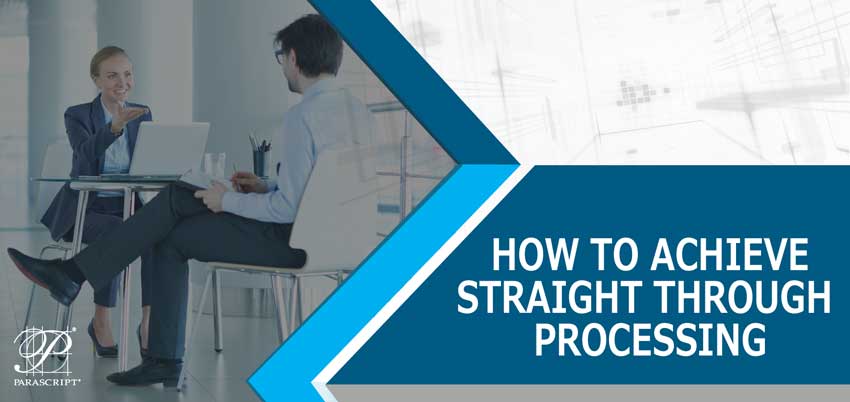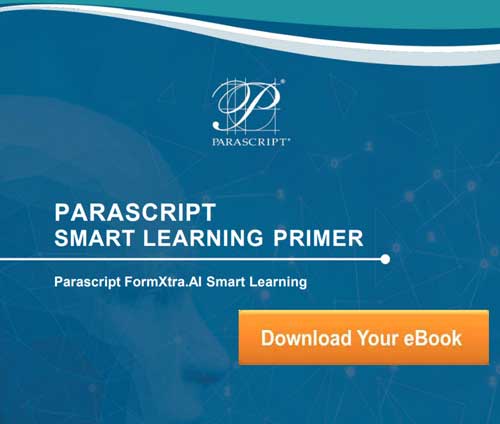How do you achieve the greatest amount of straight through processing or STP? This is the focus of the following presentation. We also want to talk about the significance of error rate, why it matters, and most importantly, what it means in terms of solution cost, capital performance, return on investment and payback. So let’s get started. You can watch the presentation below and get all of the details or read on for a brief synopsis.
Most major enterprises are running multiple ECM and repository platforms, often 10 or more with all the technical support, maintenance and diligence associated with them. Parascript FormXtra.AI can reduce labor, improve throughput and reduce errors in the document and data capture areas. It simultaneously provides optimized document processes, legacy migration, backfile conversion and data normalization as well as information governance capabilities—all from the same deployment. Simply insert FormXtra.AI into your existing digital plumbing framework. It requires neither procedural changes for your customer vendor ecosystem submitting documents nor changes to the internal business processes that they feed.
OCR Software Accuracy
Most of us in the industry have been trained to think in terms of OCR accuracy. We hear vendors say that they can achieve 99% accuracy on machine print, for example. Unfortunately, the accuracy rate that they are quoting is at the character level so if you have 1000 characters on a document, you will have 10 errors throughout the document. If you need to extract 10 or more fields from an invoice or another document, chances are that you will still touch every single document. This means zero page-level straight through processing.
Not only do we have to consider accuracy to assess our STP potential, we must incorporate the ability to separate data into two streams: one with presumably correct data and one with data that requires review. We refer to the former stream as the “read rate.” Simply put, the read rate is the amount of data released into our workflows. Of course, there will always be some level of error even in that stream of presumably correct data; it is inescapable. The objective is to get that error as low as possible. Here is an example from one of our clients.
Loan Automation Client Example
They process approximately one million pages a day in their mortgage loan processing. For the document classification tasks, human keyers do this, and their error rate is about 3.5%. They are good keyers. The average human error rate, depending upon the task, can be anywhere from 2%-6%, and sometimes even greater depending upon skill. Now, because they have low-cost offshore resources, they do all of this by hand. They scan it and then provide it to data entry operators, who then assign all documents to a particular type. With a 3.5% error rate, that means that 35,000 documents go into their loan system daily assigned incorrectly. Even with low-cost labor, the expense of manually assigning documents is still quite large.
A number of vendors in the advanced capture world leverage machine learning, but they don’t talk about STP much, and it is an important discussion.
As soon as they installed Parascript FormXtra.AI, they instantly were able to classify 85% of their entire stream of documents without any manual effort, and when adjusted for their SLA of 3.5% error, they were able to automatically classify 70% with an improved error rate of only 2% error. Now what does that mean? It means that our straight through processing went to 70% because of the way FormXtra.AI is architected using machine learning and artificial intelligence. It means that the total error rate (including manual error) went immediately from 3.5% to under 3% so our mechanized scan, classification and extraction is already better than the keyers.
Financially, it means we have the potential to save this client $1.6 million in direct labor, not expended on error correction. With a little tuning by the end of the month, we get to even higher accuracy with 2% error. Our potential savings as a function of STP becomes $1.8 million. This highlights why error rate is so critical, but nobody talks about it. A difference of only 1.6% more error (3.6%) means STP goes to zero because the system cannot deliver a rate better than human labor. A number of vendors in the advanced capture world leverage machine learning, but they don’t talk about STP much, and it is an important discussion. Watch the presentation above to understand the exact spreadsheet numbers and acquire a more detailed understanding.
Straight Through Processing and Efficiency
How does increased STP help us from an efficiency standpoint? Well, any sustained increase in throughput using the same resources has value. One way to assess that is to measure the STP coefficient of the capture environment like we do in our presentation (available above). There are a number of philosophies out there when it comes to assigning cost to errors and error correction. I typically use the the 1-10-100 rule, which brings more granularity to the picture.
If it takes one unit of work or cost to produce a transaction, it can take 10 times the level of effort to correct it when you find it while it is still in the process. If the transaction makes it all the way through the process and fails or requires attention, it can take up to 100 times the original requirements to process it. This means if it is 10x the effort to repair a defective item with 5% error, you would be using 50% or more of your workflow assets to resolve only 5% of your total transactional volume.
Parascript FormXtra.AI improves workflow performance with no investment change or costs to the workflow process. Most companies are not aware of this opportunity because there is nothing “broken” in their current capture process. However, the potential that is available through optimization with Parascript FormXtra.AI may fund the next digital transformation project. The numbers (spelled out in my presentation above) are compelling and demand a good, hard look. If you would like to get more details about Parascript or engage in an environmental analysis and opportunity assessment, contact us. We would be happy to help you explore this opportunity and potential.
###
If you found this article interesting you may find this eBook useful: Parascript Smart Learning | Machine Learning Primer:






